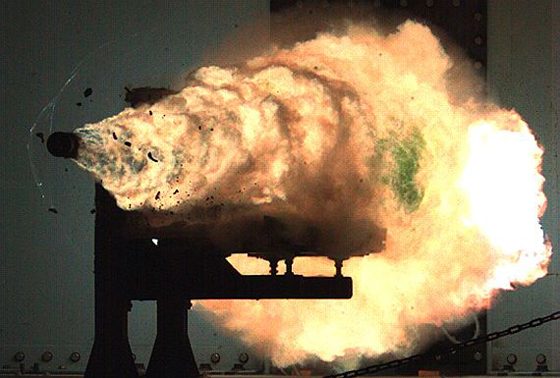Powering the Navy’s railgun
U.S. Navy researchers needed energy storage technologies to help develop a long-range shipboard weapon that fires projectiles using electrical power instead of chemical propellants. They found their solution from battery designer Saft America, who will help Navy researchers develop non-propagating energy storage modules for the future electromagnetic railgun. The electromagnetic railgun project seeks to use magnetic fields created by high electrical currents to accelerate a sliding metal conductor between two rails to launch projectiles at 4,500 mph.

The electromagnetic railgun powered by Saft America batteries
Such a shipboard weapon would use kinetic energy, rather than explosives, to destroy or disable targets at sea. The railgun will use electricity generated by its host ship and stored over several seconds in a pulsed power system. The Navy’s near-term goal is a 20- to 32-megajoule weapon that shoots a distance of 50 to 100 nautical miles. Navy officials want a rate of fire for the electromagnetic railgun of at least 10 rounds per minute. The pulsed power system will provide the electrical power necessary for this rate of fire. For more information see Saft America at www.saftbatteries.com , or the Naval Surface Warfare Center-Dahlgren at www.navsea.navy.mil/Home/WarfareCenters/NSWCDahlgren
Embedded ac-dc power supply market
Forecasts in the Worldwide ac/dc power supplies report include 41 applications including the emerging smart grid, solid state lighting, developments in building automation and electric vehicle charging, as well as in traditional areas like communications, computers, military, and industrial segments.
The embedded power supply forecasts presented in this report are based on a detailed analysis of 41 applications divided among eight distinct categories: communications, computers, industrial, solid state lighting (SSL), medical, mil/aero, consumer and smart grid. In addition to the unit/dollar forecasts, forecasts were generated for merchant/captive production, wattage, package style, packaging by industry and design type. Forecasts and analysis presented in this report consider application drivers, technology trends, standards and regulatory considerations, market drivers and other factors specific to each segment.
The medical and military/aerospace segments are projected to remain small in comparison to the other applications covered in this report. Power supplies in both of these segments must meet and comply with a number of strict standards and regulations that do not typically apply in other applications and due to the rigorous design specifications and barriers to entry, the power supply market can be challenging. However, power supplies in each of these areas are more expensive than other areas, providing an opportunity for manufacturers who are able to accept the challenges offered by this market. For more information go to: http://tinyurl.com/zu9oftw
Advertisement





